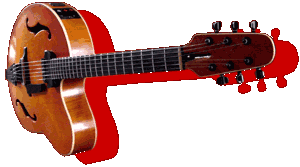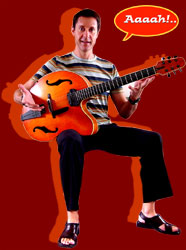The Bardophone Acoustic Electric Guitar – A Radical Approach

An acoustic electric guitar design by Jerome Barde, the Bardophone is one of the most outstanding examples of guitar design for ergonomics. Where many other guitar builders have taken only small evolutionary steps, Jerome starts with a clean slate “reconsidering the whole concept of the guitar body (proportion, volumes, shapes, balance, angle) and by looking for an attractive and elegant design”.
A professional guitar player for 25 years, Jerome became interested in making a guitar that would sit well when seated. The result of a long design phase and several prototypes, the Bardophone is an impressive reinterpretation of what an ergonomic guitar can be.
On his web site, Jerome defines the issues with conventional guitar designs as follows:
A traditional guitar is structurally made in a way that it is impossible to play it in a correct position without using all kinds of awkward stratagems that can have bad physical effects on the guitarist:
– Using a guitar stool (like classical guitarists) warps your spine and alters the blood circulation in the leg on the stool!
– Folding your legs obstructs the blood stream in the higher leg!
– Using a strap puts weight on your shoulders and your spine!
If you try not to use any of these tricks, your right shoulder (for a right handed person) will stand too high and your left hand will play the guitar’s neck in a position that is too low to achieve a respectable velocity ! The ones who still try, end up with a bent back!
As you can see, Jerome’ guitar design succeeds in solving these ergonomic issues. The guitarist now sits in a healthy, neutral and relaxed position with the guitar neck angled up to reduce wrist flexion.

Awarded both United States and European patents, Jerome Barde is looking for a guitar builder to bring his design to market. Visit his site to find out more about the Bardophone acoustic electric guitar.
Ergonomic guitars, like hybrid cars, tend to be less attractive in form that the traditional designs. The funky thing about this design are the f-holes. They look way out of place, and they don’t even come close to referencing the bridge position.
The bottom left photo on the inventor’s webpage, you link to, presents the guitar pretty well. The body is much smaller than the other images convey. It actually looks neck heavy, but I know the guy wouldn’t permit it. The f-holes, bridge and binding obviously provide style cue value connecting to traditional guitars. It seems like the f-hole locations can’t reference the bridge position the conventional way because of the body shape and angle. The purpose of f-holes isn’t to ref. the bridge position anyway, but I understand Eric’s point about traditional design symmetry.
Robert, very cool find that fits your theme so perfectly! The builder’s viewpoints and yours seem to align pretty closely.
Eric’s point about hybrid cars is interesting however, hybrid cars don’t have to look different. Toyota and Honda created unconventional bodies for their hybrids to emphasize and market the unconventional idea of a hybrid.
Car bodies are optimum when aerodynamics, handling and safety are addressed. In this sense, cars are ahead of guitars. A closer comparison might be basketball shoes. Today’s shoes are light years more orthopedic in design than those old Converse Chuck Taylors were, but clever marketing positions newer, better shoe designs with popular culture instead of an orthopedic stigma associated with the elderly and disabled of our society.
Even using the term “ergonomic” with regard to guitars, in the context of injury prevention, is a pop euphemism for “orthopedic”. We can all agree that Building the Ergonomic Guitar sounds more hip than Building the Orthopedic Guitar.
The world is full of aging guitar heroes, some of whom will inevitably shift their focus to this area. But ultimately it’s gotta be positioned cool like sports gear. Leo Fender’s Stratocaster wasn’t so cool until Buddy Holly had one around his neck. Coulda been any guitar– even an ergonomic/orthopedic one…
I gotta agree with you on that one eric.. they always seem less like a guitar and more like some freaky instument 😯
I would suggest that much of this is a matter of tastes changing to reflect new trends and ideas. To continue with eric’s car reference, consider how automobile design has changed. Cars have gone from literally looking like horseless carriages to tail fins to the streamlined vehicles we see today. At each step, people’s expectations were challenged by the new and eventually evolved to incorporate the new.
Similarly, when the first Fender Stratocaster came out, it was considered quite radical and was even looked down upon by traditionalists. Look at the Strat now – it is inextricably a part of our collective consciousness.
[…] Building the Ergonomic Guitar discusses the Bardophone Acoustic Electric Guitar. […]
[…] An acoustic electric guitar design by Jerome Barde, the Bardophone is one of the most outstanding examples of guitar design for ergonomics. Where many other guitar builders have taken only small evolutionary steps, Jerome starts with a … …more […]
I love this design, such a nice change…although I agree, the photo shown here doesn’t do justice to the actual guitar, shown on his site, which is much smaller. I’d love to see an acoustic version.
Absolutely right Mickey. The images weren’t the greatest but its certainly an interesting design.
However, note that the photo of the man sitting is Jerome Barde with the actual guitar so that should give you some idea of its size.